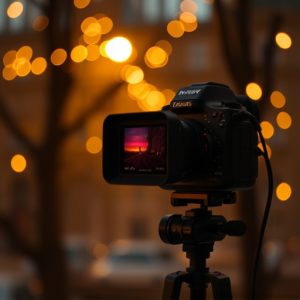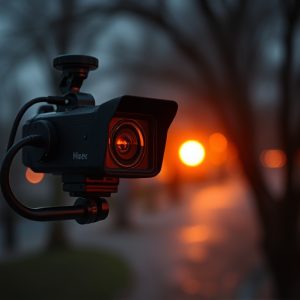Mastering Indoor Security: Wireless Night Vision Camera Detection Methods
Wireless Night Vision Security Cameras Indoors have revolutionized security with advanced optical se…….
Wireless Night Vision Security Cameras Indoors have revolutionized security with advanced optical sensors amplifying available light for clear images in low-light conditions. They offer remote monitoring, recording, and alert capabilities, enhancing indoor safety. Optimal sensor coverage involves a mix of fixed and mobile cameras, while cloud integration enables remote access. Strategic camera placement, infrared illumination, lens cleanliness, and calibration compensate for lighting changes and temperature variations, improving accuracy. Continuous monitoring and maintenance are crucial for these systems' optimal performance, preventing false alarms and ensuring swift threat response.
Wireless Night Vision Security Cameras have transformed indoor surveillance, offering unparalleled visibility in low-light conditions. This article delves into the intricacies of optical sensor detection, providing a comprehensive guide for professionals. We explore the foundational knowledge of wireless night vision cameras, dissecting their capabilities and limitations in indoor security. Learn about advanced placement techniques, calibration methods, and maintenance strategies to ensure optimal sensor coverage and uninterrupted surveillance with these innovative systems.
- Understanding Wireless Night Vision Cameras: A Foundation for Effective Sensor Detection
- The Role of Optical Sensors in Indoor Security: Capabilities and Limitations
- Professional Methods for Optimal Sensor Coverage: Strategies and Tools
- Advanced Techniques for Night Vision Camera Placement and Calibration
- Continuous Monitoring and Maintenance: Ensuring Uninterrupted Surveillance with Wireless Systems
Understanding Wireless Night Vision Cameras: A Foundation for Effective Sensor Detection
Wireless Night Vision Security Cameras Indoors have become a cornerstone in home and business security systems, offering enhanced visibility and peace of mind in low-light conditions. These cameras leverage advanced optical sensor technology to capture clear images even in complete darkness, making them indispensable for monitoring sensitive spaces. Understanding how these sensors work is key to effective detection methods.
At the heart of Wireless Night Vision Security Cameras lies an intricate balance between image intensification and sensor sensitivity. They utilize low-light imaging techniques, amplifying existing light signals to produce vivid images. This process involves specialized sensors that can detect even minimal light levels, enabling them to capture details in darkness. By combining this technology with wireless connectivity, users enjoy the convenience of remote monitoring and recording from virtually anywhere, further fortifying security measures both indoors and beyond.
The Role of Optical Sensors in Indoor Security: Capabilities and Limitations
Optical sensors play a pivotal role in enhancing indoor security, offering advanced surveillance capabilities through wireless night vision security cameras. These sensors are designed to detect and capture high-resolution images even in low-light conditions, ensuring round-the-clock monitoring. By integrating cutting-edge technology, optical sensors can analyse and interpret visual data, triggering alerts when suspicious activities occur. This real-time monitoring is invaluable for businesses and homeowners seeking comprehensive protection against unauthorized access or potential threats.
Despite their remarkable capabilities, optical sensors have certain limitations indoors. Factors such as poor lighting conditions, obstructions like furniture or curtains, and natural obstacles can impact the accuracy and effectiveness of these sensors. Additionally, false alarms remain a concern due to the sensor’s sensitivity, which might require constant fine-tuning for optimal performance. Nevertheless, ongoing advancements in sensor technology are addressing these challenges, pushing the boundaries of indoor security further.
Professional Methods for Optimal Sensor Coverage: Strategies and Tools
In the realm of wireless night vision security cameras indoors, achieving optimal sensor coverage is paramount for effective surveillance. Professional methods leverage advanced tools and strategies to ensure every angle is monitored seamlessly. One such strategy involves employing a combination of fixed and mobile sensors, allowing for both broad area coverage and targeted monitoring. Fixed sensors are strategically placed at key locations, while mobile sensors provide dynamic coverage, tracking movement and adapting to changing conditions.
Additionally, artificial intelligence (AI) and machine learning algorithms play a pivotal role in enhancing sensor performance. These technologies enable cameras to recognize and differentiate between people, vehicles, and other objects, improving accuracy and minimizing false alerts. Integration with cloud-based systems facilitates remote monitoring and data storage, making it convenient for security personnel to access live feeds and recorded footage from anywhere at any time. This holistic approach ensures comprehensive sensor coverage, enhancing the overall effectiveness of indoor security measures for wireless night vision security cameras.
Advanced Techniques for Night Vision Camera Placement and Calibration
In the realm of optical sensor detection, especially for indoor wireless night vision security cameras, advanced techniques play a pivotal role in enhancing performance and accuracy. Night vision camera placement involves strategic positioning to maximize low-light visibility while minimizing false triggers caused by ordinary lighting fluctuations. Professional methods include employing infrared (IR) illumination, ensuring lenses are clean and free from debris, and calibrating the sensor for optimal dynamic range and color accuracy under dark conditions.
Calibration processes must account for temperature variations that can affect IR performance and image quality. Advanced techniques also involve sophisticated algorithms that can compensate for these changes, allowing wireless night vision security cameras to deliver clear, detailed images even in complete darkness. This meticulous approach ensures that indoor spaces are effectively monitored 24/7, providing homeowners and business owners alike with unparalleled peace of mind.
Continuous Monitoring and Maintenance: Ensuring Uninterrupted Surveillance with Wireless Systems
Continuous Monitoring and Maintenance play a pivotal role in ensuring uninterrupted surveillance, especially with the integration of wireless night vision security cameras indoors. Wireless systems offer unparalleled flexibility and convenience, allowing for easy setup, repositioning, and access to real-time video feeds from anywhere within range. This continuous observation is crucial for proactive security measures, enabling quick response times to potential threats.
Regular maintenance of these systems ensures optimal performance and longevity. With wireless night vision cameras, regular checks include verifying signal strength, testing battery life (for battery-powered units), and ensuring lens clarity. Proactive monitoring can prevent false alarms, system malfunctions, or security breaches by identifying and addressing issues promptly.
Wireless Night Vision Security Cameras Indoors offer a sophisticated solution for enhancing indoor security, leveraging optical sensor detection and advanced imaging technologies. By understanding the foundational concepts, recognizing the unique challenges of indoor environments, adopting professional deployment strategies, and implementing continuous monitoring, security professionals can maximize the capabilities of these cameras. This comprehensive approach ensures optimal sensor coverage, accurate data collection, and uninterrupted surveillance, fostering a safer and more secure environment.


